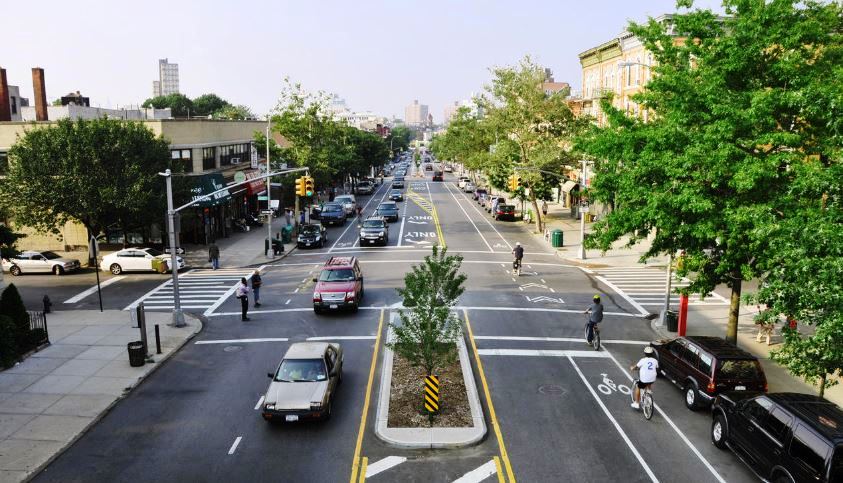On July 19, 2018, the Natural Resources Defense Council unveiled a “roadmap” for fixing a broken transportation system in the Northeast and the Mid-Atlantic regions of the United States.
That antiquated system is contributing to climate change, air pollution, overcrowded highways, deteriorating public transit systems, lost economic opportunities, rural isolation, and inequality for low-income people. Redesigning and renewing it will thus contribute to equitable community revitalization and environmental / climaterestoration.
NRDC released its roadmap report to help guide a bipartisan coalition of seven governors and the mayor of Washington, DC, who have committed to developing a regional clean transportation plan.
Their goal is to cut climate-altering carbon pollution from the nation’s largest source—the transportation sector. It follows the successful Regional Greenhouse Gas Initiative that has slashed carbon pollution from the region’s power plants.
“Our transportation system is broken. It needs an extreme makeover. Everyone has a story—we suffer in gridlock, choke on car and truck exhaust, drive on decaying roadways, cope with substandard public transit, and walk and bike on dangerous streets,” said Bruce Ho, senior advocate and principal author of NRDC’s report.
“That’s why it’s exciting to see Northeastern and Mid-Atlantic states step up, and move toward fixing these chronic problems with a modern, regional transportation plan. States in this region have a golden opportunity to transform transportation—becoming a model for the world—as they create cleaner, safer and more livable cities, towns and rural communities. This is a big deal. Let’s get this show on the road,” he continued.
NRDC released “Transportation Reimagined: A Roadmap for Clean and Modern Transportation in the Northeast and Mid-Atlantic Region” in state-focused telephone press conferences today. The groundbreaking report outlines what might work in the states based on existing strategies already piloted around the country that could be implemented more broadly.
They include: substantially expanding electric cars, trucks, buses (EVs); encouraging more walkable and bike-friendly living areas; upgrading public bus, train and subway transit; reducing congestion; and addressing rural and low-income communities that are particularly underserved today when it comes to their transportation needs.
Following the roadmap would yield enormous health and environmental benefits. That includes generating billions of dollars of economic growth, major job expansion, improved safety and mobility, reduced respiratory illnesses and asthma, and a safer climate.
“U.S. investors and companies strongly support policies that promote a clean and efficient transportation system,” said Carol Lee Rawn, director of transportation at Ceres, who joined the event. “Transportation is the largest contributor to U.S. greenhouse emissions and a critical driver of the economy. The measures outlined in this report — including clean vehicles, strong public transportation systems, and robust pedestrian and cycling infrastructure — provide significant economic benefits as well as critical emissions reductions.”
Last fall, governors in Connecticut, Delaware, Maryland, Massachusetts, New York, Rhode Island, and Vermont, and the mayor of Washington, DC committed to developing a regional clean transportation plan.
So far this year, the states have held several public listening sessions to gather comments and recommendations on that plan. The most recent one wase on July 24, 2018 in New York City.
Some regional benefits from a cleaner transportation system include:
- Reducing gasoline consumption, saving consumers more than $100 billion by 2035;
- Creating 125,000 new jobs and adding $17.7 billion per year to the region’s economy by 2030;
- Reducing pedestrian and cyclist deaths, which numbered 970 and 115 people respectively in 2016; and
- Improving air quality and health. Nearly 60 percent—37 million people—in the region live in areas that do not meet national air quality standards for fine particulate matter, ozone pollution, or both.
NRDC’s report offers specific benefits and opportunities for urban, suburban and rural communities from transforming the transportation system:
Rural Communities:
- Expanding public transit, providing flexible route bus service and better rapid transit could ease key rural problems. Rural households spend 7 percent more of their budgets on transportation compared to their urban counterparts. Rural workers travel 38 percent more than urban workers, and low-income rural workers travel 59 percent more;
- Improved mobility options for older Americans can keep them independent, decrease isolation and connect them with medical services; and
- Creating walkable, bikeable Main Streets could improve quality of life.
Suburban Communities:
- Strategies include improving pedestrian walkways and bike lanes in suburban communities, and linking them to transit corridors;
- Intercity rail should be expanded to help commuters get to their jobs, particularly low-income and service workers. Electrified commuter trains and other infrastructure upgrades could reduce emissions and improve speeds and efficiency; and
- Suburban communities should develop more electric vehicle charging stations, which would support transitioning drivers out of gasoline-fueled vehicles to electric vehicles, reducing emissions.
Urban Communities:
- Cities should develop more compact, multi-use housing and businesses, walkable and bikeable neighborhoods and improved public transit, all of which could reduce roadway congestion. Today, three of the top 10 most traffic congested cities in the Northeast and Mid-Atlantic region are Boston, New York and Washington, DC;
- Cities should ensure development of affordable housing near public transit. This can revitalize vacant parcels, while preventing displacement from gentrification;
- More electric buses and other clean vehicles should be deployed, reducing emissions, making neighborhoods quieter and improving air quality; and
- Cities should switch to electric-powered heavy trucks and other equipment at ports, airports, and truck depots to reduce pollution in surrounding neighborhoods, which often are low-income and communities of color.
NRDC is calling on local, state and regional leaders to act boldly in designing a 21st century transportation system. Achieving that vision will require new investment in technologies and infrastructure, new policies and funding, strong political leadership, and public engagement.
Photo courtesy of New York Department of Transportation.

